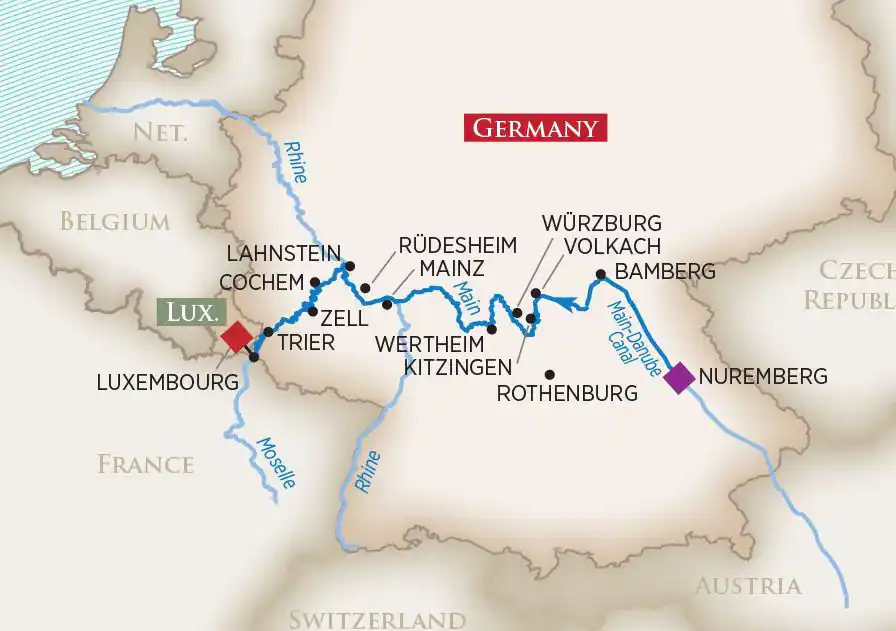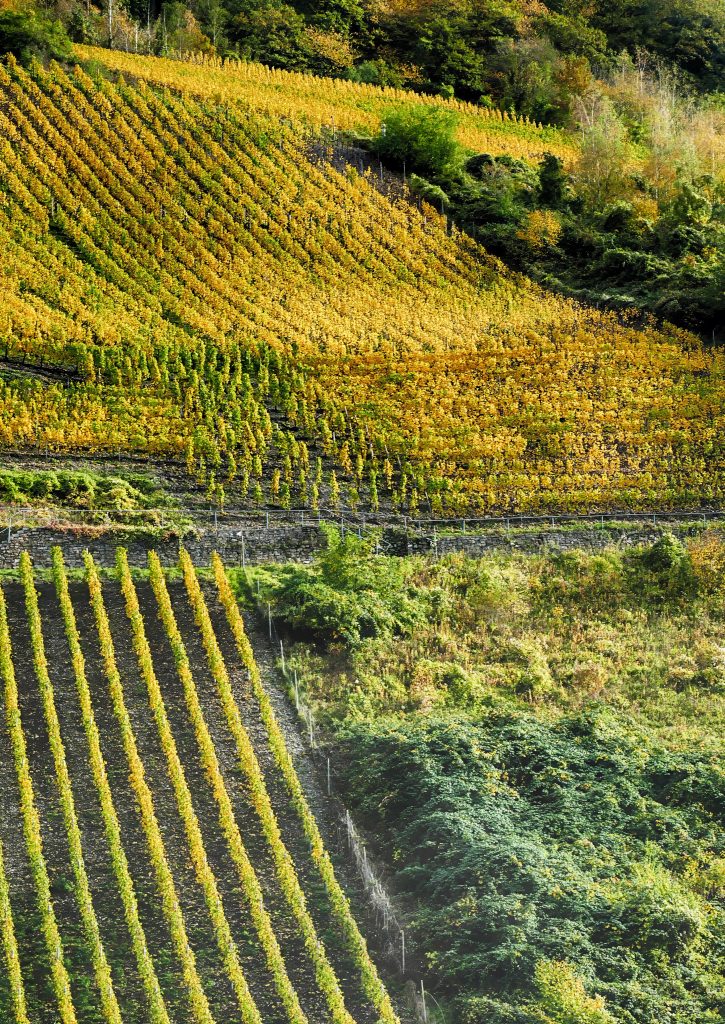The steep hills with views of the Rhine River
and the Mosel and their tributaries were perfect for vine planting. No one knew this better than the Romans. Roman poet Ausonius describes the verdant hills covered in Bacchus grapes and the pleasant, softly running streams of the “Mosella” in a poem dated around 370 AD. Like their influence in Burgundy and the rest of France, Cistercian and Benedictine monks had a significant role in the creation and production of fine wine during the Middle Ages in numerous German wine areas. But the growing popularity of beer, particularly in the country’s north, caused it to start declining in the 17th century.

Superior sweet “late harvest” wines began to emerge in the late 1700s. By the early 19th century, these wines—known as Spatlese wines—were fetching prices higher than first-growth Bordeaux because they were produced from Riesling grapes afflicted with botrytis, or noble rot! With two World Wars and post-war austerity, the 20th century saw yet another significant drop in the amount of high-quality German wines produced. Winemakers’ reputations suffered because of their concentration on creating vast amounts of blended sweet wines from subpar grapes.
Located at approximately 50 ̅ north latitude,
Germany is home to some of the world’s most northern vineyards. Frigid winters and moderate summers result from the cool climate. German wine is largely dependent on the Rhine and its tributaries. Sunshine is reflected onto the vineyards by the running water, warming the vines and promoting grape ripening. Vineyards are situated on incredibly high slopes facing south. No other agriculture can flourish there. There would have been a forest or just naked mountains if not for the vines.
Our AMAwaterways Rivers & Castles cruise let us sample typical local wines while cruising past steep hillsides covered with vineyards.
Medieval Marvels: Rhine Castles AMAwaterways Cruises
Besides the excursions and scenic views of a river cruise, this was also a wine cruise – one of the specialty offerings of AMAwaterways cruises. Each night local wines complemented the a la carte menu. We were able to taste many local wines; unfortunately, many are never exported, so we’ll need to re-book this cruise to enjoy th em again.

In addition to the paired wines offered at meals, our wine cruise included Special events included 2 mid-morning tastings. The first event sampled a variety of Rieslings and the 2nd of even rarer Franconia dry wines, a delight for even neophyte Oenophiles.
We endured long days of gustation – several post-breakfast wine or beer tastings, lunch with beer or wine, welcome & farewell champagne toasts, afternoon tea, the sip n sail (a free drinks, happy hour), then drinks at dinner. However, judicious imbibing produced no hangovers; unlike ocean cruises where the objective emphasizes mass quantities rather than curated samplings. [and I maintained my record of never gaining weight on a cruise].


On our last day moved we from wine drinking Franconia to beer drinking Franconia – the latter’s special is smoked beer – definitely an acquired taste, (I’d use it for braising pork chops or sausages). But I also found a good local lager – pairing it with bratwurst & sauerkraut before returning to the ship for our regular lunch.
<rant> In my totally unbiased opinion, European lagers easily surpass the mainstream swill offered by major American brands; though American microbrews are now finally offering comparable lagers. But the ultimate lagers remain Budvar (not to be confused with Budweiser, its bastardized American version), and Pilsner Urquell from Czechia. My beer styles of choice remain Pacific Northwest IPA and stouts. In Prague I talked with local brewers and discovered even Prague breweries now import our local Northwest hops. Previously, IPA were unknown in Europe. Now many pubs and restaurants serve excellent brews. Just order what’s on tap (‘pression’ or ‘vom fass’ or just ‘pivo’) to get the best local brews and never be disappointed</rant>
The Moselle and Rhine rivers
are two of the most famous wine-producing regions in Europe, known for their picturesque vineyards and high-quality wines.: Riesling is the most renowned grape variety in both the Moselle and Rhine regions. It produces aromatic white wines known for their crisp acidity, floral aromas. Riesling is typically included in the “top three” white wine varieties along with Chardonnay and Sauvignon blanc. Riesling is highly “terroir-expressive”, meaning that the character of Riesling wines is greatly influenced by the wine’s place of

Germany, one of the most famous regions for Riesling production, uses the Prädikat system to classify their Rieslings based on ripeness at harvest.
Kabinett (least ripe) wines have little to no residual sugar, resulting in a crisp, clean taste. They are fermented until most of the sugar is converted to alcohol. Dry Rieslings can have notes of citrus, green apple, and mineral characteristics.
Spätlese (late harvest), Off-Dry Riesling wines have a hint of sweetness, with a balanced acidity. They may have a touch of residual sugar, which can provide a pleasing contrast to the acidity. They often have flavors of ripe fruit like peach, apricot, and honey.
Auslese (select harvest), Semi-Sweet Riesling wines have noticeable sweetness, but they are not cloyingly sweet. They typically have a good balance between sweetness and acidity, offering flavors of ripe fruits with a touch of sweetness.
Sweet Riesling wines are noticeably sweet, often with residual sugar levels that are quite high. They can range from lusciously sweet to dessert wine levels of sweetness, with flavors of candied fruits, honey, and sometimes botrytis-induced characteristics (like honeyed or apricot notes). Beerenauslese, Eiswein, and Trockenbeerenauslese are three different types of high-quality German dessert wines that are made from grapes affected by noble rot (Botrytis cinerea). Each of them has unique characteristics and production methods
Beerenauslese (BA): “Selected Harvest of Berries” wine is made from individually selected, overripe grapes that have been affected by noble rot. The grapes are handpicked, and only those with the highest sugar concentration and noble rot are chosen. The result is a very sweet and rich wine.
Beerenauslese wines have high levels of residual sugar. The natural sugars in the grapes are concentrated due to the noble rot and the late harvesting process. They exhibit a wide range of flavors, including honey, tropical fruits, and sometimes a hint of botrytis character (like mushroom or earthy notes).
Pairing: Beerenauslese wines pair well with desserts, particularly those featuring fruits or cream-based elements.
Eiswein: “Ice Wine” is made from grapes that have frozen on the vine. They are harvested in temperatures below freezing, and the grapes must remain frozen during the entire process, including pressing. Because the water in the grapes is frozen, it is left behind during pressing, resulting in a highly concentrated, sweet juice.
Like Beerenauslese, Eiswein is very sweet due to the concentration of sugars resulting from the freezing process. It tends to have intense fruit flavors, often with a crisp acidity that balances the sweetness. Common flavors include apricot, peach, and tropical fruits.
Pairing: It pairs well with a variety of desserts, but also complements rich, creamy cheeses.
Trockenbeerenauslese
(TBA):- “Selected Dry Berries” s made from individually selected, fully botrytized grapes that have become raisined due to the noble rot. Impress your friends with this run-on name. The grapes are often shriveled and have a very high sugar concentration.
TBA is one of the sweetest types of German wines, with extremely high levels of residual sugar.: It typically has concentrated flavors of dried fruits, honey, and sometimes a touch of botrytis character.
Pairing: This wine is often enjoyed on its own or with very light accompaniments like fresh fruit.
How Trockenbeerenauslese is made:
The first and most crucial step in making Trockenbeerenauslese is the careful selection of grapes. Grapes affected by noble rot are left on the vine until they are almost raisin-like in appearance.
This fungus Botrytis cinerea (“noble rot”) pierces the skin of the grape, allowing moisture to evaporate and sugars to concentrate. It also imparts unique flavors and aromas to the grapes.
These wines have deeper layers and larger concentrations of sugar, acid (which balances the sugar), flavor, and complexity. When combined, they produce some of the best-aging white wines. The late 1700s at Schloss Johannisberg saw the discovery of the beneficial application of “noble rot” to Riesling grapes. The owner of the vineyard, the Abbey of Fulda, started harvesting too late – the Riesling grapes had begun to rot, but the wine made from them was outstanding
The grapes are usually harvested by hand,
as the delicate and shriveled berries can easily burst, and mechanical harvesters are not suitable for this purpose. Next, the grapes are gently pressed, extracting the sweet, concentrated juice. Due to the small amount of juice in each grape and the labor-intensive nature of this process, the yield is very low compared to other wine styles. The juice is fermented slowly, at cool temperatures, preserving the delicate aromas and flavors. Depending on the winemaker’s preferences and the specific conditions of the vintage, fermentation proceeds in stainless steel tanks, old oak barrels, or a combination of both.
After fermentation, Trockenbeerenauslese wines typically age in stainless steel tanks or small oak barrels allowing the wine to develop and mature. The aging process helps to integrate flavors and achieve a balanced profile. Once the winemaker determines that the wine has achieved the desired level of maturity and balance, it is filtered and then bottled.
Trockenbeerenauslese wines benefit from further aging
in the bottle. The high sugar and acidity levels provide excellent aging potential, and the wine continues to evolve and develop complex flavors over time.
Thus, Trockenbeerenauslese is highly labor-intensive and a risky process. The weather conditions and presence of noble rot are crucial factors greatly influencing a vintage’s. These relatively rare Trockenbeerenauslese wines command high prices due to their exceptional quality and limited availability.


Other wines of the Rhine
Spätburgunder (pinot noir) is a red grape variety that is grown along both the Moselle and Rhine rivers. It is used to produce red wines with a wide range of styles, from light and fruity to more complex and structured.
Müller-Thurgau is a white grape variety that is a cross between Riesling and Madeleine Royale. It was created to be an easier-to-grow alternative to Riesling and is used to produce light, fresh, and fruity white wines.
Elbling is an ancient white grape variety that has been cultivated along the Moselle for centuries. It produces crisp, high-acid wines that are often used for sparkling wine production.
Dornfelder is a red grape variety that was bred in Germany. It is known for producing deep-colored red wines with a range of flavors from red and black fruits to earthy and spicy notes.
Grauburgunder (Pinot Gris) is a white grape variety that is related to Pinot Noir. It produces full-bodied white wines with flavors of ripe fruits, often with a slightly spicy or nutty character.
Weißburgunder (Pinot Blanc) another white grape variety related to Pinot Noir. It produces fresh, crisp white wines with flavors of green apples, citrus, and sometimes a subtle nuttiness.
Kerner is a white grape variety that is a cross between Riesling and Trollinger. It produces aromatic white wines with a good balance of acidity and fruitiness.
Scheurebe is a white grape variety that is a cross between Riesling and Silvaner. It is known for its aromatic and fruity character, often with notes of black currant and elderflower.